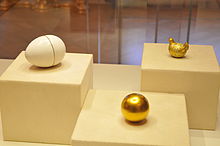First Hen Egg
| First Hen Fabergé egg | |
|---|---|
 |
|
| Year delivered | 1885 |
| Customer | Alexander III of Russia |
| Recipient | Maria Feodorovna |
| Current owner | |
| Individual or institution | Viktor Vekselberg |
| Year of acquisition | 2004 |
| Design and materials | |
| Workmaster | Erik Kollin |
| Materials used | Gold, opaque white vitreous enamel, rubies, ruby pendant, diamonds |
| Height | 64 mm (2 1/2 in.) |
| Width | 35 mm (1 3/8 in.) |
| Surprise | The egg opens to reveal a gold yolk. Inside the yolk is a gold hen which opened to reveal a diamond and gold crown which contained a ruby pendant. The crown and pendant are now missing. |
The First Hen Egg or Jeweled Hen Egg is a Tsar Imperial Fabergé egg, the first in a series of fifty-four jeweled eggs made under the supervision of Peter Carl Fabergé for the Russian Imperial family. It was made and delivered to Tsar Alexander III of Russia in 1885. The tsarina and the tsar enjoyed the egg so much that Alexander III ordered a new egg from Fabergé for his wife every Easter thereafter. The egg is currently located in Russia as part of the Vekselberg Collection, and is housed in the Fabergé Museum in Saint Petersburg, Russia.
The crafting of the first Imperial egg is attributed to Erik Kollin of Fabergé's workshop. The egg is made of gold completely coated with opaque white enamel to look like a real egg shell. A thin band of gold where the two halves of the shell are joined is visible around the middle of the egg. It is 64 mm (2 1/2 in.) long and 35 mm (1 3/8 in.) wide. The two halves of the outer shell fit together in a bayonet-style fitting which opens when twisted to reveal the surprise.
The two halves open to reveal a gold yolk with a matte finish, containing a varicolored gold hen with ruby eyes. The hen is hinged on the tail feathers which allows it to also open up to reveal two additional surprises which are now missing. The first of these was a gold and diamond replica of the imperial crown. Suspended within the crown as the final surprise was a tiny ruby pendant. A necklace chain was included so the Tsarina could wear the pendant.
In the 19th century, Russian Orthodox Christians held Easter as the most important day of the year. Following a strict fast throughout all of Great Lent, Easter was a day of celebration of Christ's resurrection. To celebrate this holiday, Tsar Alexander III's brother, the Grand Duke Vladimir Alexandrovich ordered Peter Fabergé to create an Easter surprise for the Tsarina. Correspondence between the Tsar and his brother dated March 21, 1885 indicates the Grand Duke relayed the Tsar's desires and instructions for the gift to Fabergé rather than the Tsar himself supervising the crafting of the egg. Amid terrorist attempts on the Imperial family's lives, the Tsar wanted to give his wife something that would take her mind off worries for the Easter of 1885. Fabergé created an egg inspired by one the Tsarina knew from her childhood as a princess of Denmark's royal court. The egg, still in the Royal Danish Collection, is made of ivory instead of gold, has a ring instead of a pendant inside, and dates to the 18th century. Fabergé undoubtedly chose the design because the Tsarina would have recognized the design from her youth. The design delighted both the Tsar and Tsarina so much the Alexander III ordered one for the next Easter and granted Fabergé "permission...to bear the title Supplier to the Imperial Court with the right to bear the State Coat of Arms in his shop's sign".
...
Wikipedia
